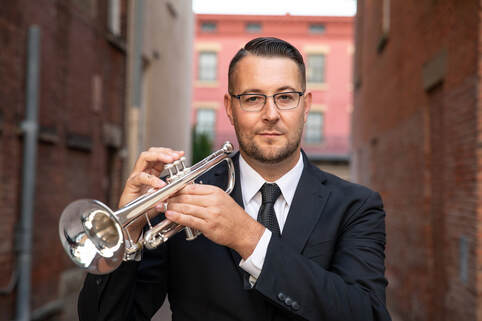
I have many goals when teaching my students, all of which serve to produce musicians who are well-rounded musically, professionally and personally. Through my teaching, I strive to instill a lifelong love of and respect for music by creating a diverse performance curriculum that is both educational and challenging.
When teaching, I aim to guide students towards a solution rather than simply present an answer. This self-driven process encourages students to develop a solution-finding technique that works for them while encouraging independence. It also ensures a personal connection between the student and the solution, which results in a deeper understanding of the concept while also developing critical thinking and the ability to teach others.
Each student is unique and there is no single style of teaching that fits all individuals. My approach to developing a relationship and educational rapport with my students centers on determining the type of learning style that works best with each individual. Together the student and I identify their strengths and weaknesses and create a list of goals for a personalized and systematic plan for musical growth. This process consists of using diverse pedagogical materials to support the student in a methodical manner. I am a firm believer in students developing excellent fundamentals; nevertheless, I also recognize that preparing students to be successful in the ever-evolving field of music requires challenging the student to be educationally well-rounded, creative, and a problem solver.
Since it is common to see a studio take on the character traits of the major professor, being a role model and mentor to my students is imperative to me. I hold myself to the highest standards and do the same for my students by assessing their preparedness, participation, improvement, use of critical thinking and sincere effort towards their studies. Studio class offers another opportunity for my students to build on their musicianship by promoting the idea that we all learn from one another. Studio classes consist of student and guest performances along with lectures which cover diverse topics such as performance preparation, musical history, pedagogy, and entrepreneurial skills.
Another key feature in developing musicianship is listening to other artists as often as possible. Through listening, students develop a sense of what it sounds like to be a proficient musician, and there is immense value in learning through example. My goal is to expose students to performances and performers within as well as outside of the music school to expand their worldly view and diversify their knowledge. I encourage students to listen to professional recordings, recitals and performances, and also participate in conferences and competitions. This promotes thought and self-evaluation, ultimately enhancing the student’s learning through imitation and inspiration.
Overall, the environment I seek to develop as a teacher is one that is supportive, diverse, and individualized. I aim to foster camaraderie and a sense of community amongst the members of my studio with the goal of producing well-rounded musicians who can and will be successful in the careers of their choice.
When teaching, I aim to guide students towards a solution rather than simply present an answer. This self-driven process encourages students to develop a solution-finding technique that works for them while encouraging independence. It also ensures a personal connection between the student and the solution, which results in a deeper understanding of the concept while also developing critical thinking and the ability to teach others.
Each student is unique and there is no single style of teaching that fits all individuals. My approach to developing a relationship and educational rapport with my students centers on determining the type of learning style that works best with each individual. Together the student and I identify their strengths and weaknesses and create a list of goals for a personalized and systematic plan for musical growth. This process consists of using diverse pedagogical materials to support the student in a methodical manner. I am a firm believer in students developing excellent fundamentals; nevertheless, I also recognize that preparing students to be successful in the ever-evolving field of music requires challenging the student to be educationally well-rounded, creative, and a problem solver.
Since it is common to see a studio take on the character traits of the major professor, being a role model and mentor to my students is imperative to me. I hold myself to the highest standards and do the same for my students by assessing their preparedness, participation, improvement, use of critical thinking and sincere effort towards their studies. Studio class offers another opportunity for my students to build on their musicianship by promoting the idea that we all learn from one another. Studio classes consist of student and guest performances along with lectures which cover diverse topics such as performance preparation, musical history, pedagogy, and entrepreneurial skills.
Another key feature in developing musicianship is listening to other artists as often as possible. Through listening, students develop a sense of what it sounds like to be a proficient musician, and there is immense value in learning through example. My goal is to expose students to performances and performers within as well as outside of the music school to expand their worldly view and diversify their knowledge. I encourage students to listen to professional recordings, recitals and performances, and also participate in conferences and competitions. This promotes thought and self-evaluation, ultimately enhancing the student’s learning through imitation and inspiration.
Overall, the environment I seek to develop as a teacher is one that is supportive, diverse, and individualized. I aim to foster camaraderie and a sense of community amongst the members of my studio with the goal of producing well-rounded musicians who can and will be successful in the careers of their choice.